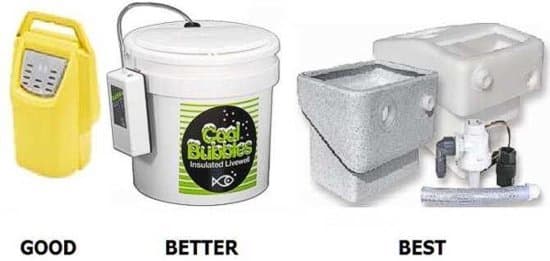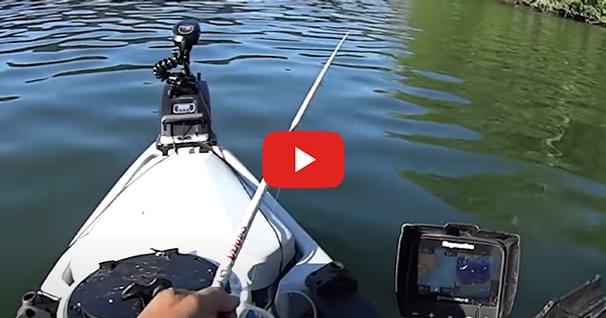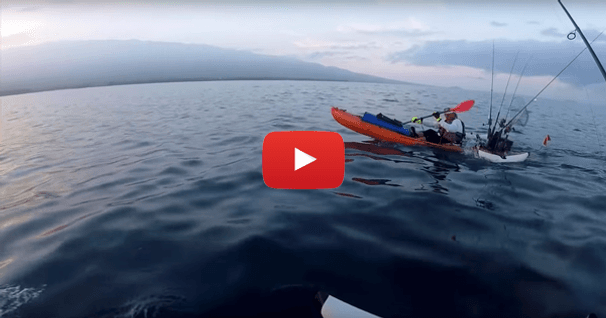Paddle Fishing with Live Bait
We've all watched "A River Runs Through It." Man engaging fish in a gentleman's duel. A hand-made dry fly versus basic instinct. Every body of water becomes the Blackfoot River in Montana. Blocking out all of our daily troubles to focus on the challenge at hand. The art and mechanics of the cast. The science and skill of the presentation. Admiring the prize at the end of the battle. The "high five" that is only heard deep in your soul.
Now, think back to your childhood. Remember what it was like to see a red and white bobber about six inches below the water's surface. The cast wasn't that important. The placement wasn't that important. You weren't engaged with any opponent. You were just fishing. The only important thing was the moment, and the memory. Today, my favorite artificial lure is a red and white topwater plug. I'm convinced that there's some deep psychological link between that red and white bobber and my Skitterwalk. But, that's another article, and another forum.
I've done my share of all sorts of fishing, enjoyed them all. But as a paddle angler, it's easy to follow the crowd, and opt to toss only artificial baits. I'll probably always be partial to arti's - I'm a collector. But, I freely admit that some of my best fishing experiences have occurred as a result of using live bait. There are many solutions available to us now so that we can revisit those memories, but from human powered boats. In this issue, I'll discuss some of the methods to acquire, transport, and sustain live bait.
WHY MANY ANGLERS DON'T USE LIVE BAIT Artificial baits are simply much easier to use in a paddle craft. Tie it on, give it a toss, you're fishing. To use live bait, it's a completely different process. Not really more or less difficult than using arti's, just different. Then at the end of the day, there's more clean-up.
WHY WE SHOULD TRY IT Simple. Because it works, many times when nothing else will. Regardless of what type of fish you're targeting, they don't start their feeding process by looking to eat something artificial. They are looking to eat what they ate yesterday, and the day before that. If you present them with that, chances are you'll be rewarded.
HOW TO GET BAIT Methods will differ, depending on where you're fishing, but I'm sure some of these methods will work for you.
- BUY IT - Most bodies of water that allow angling will also be flanked by bait and tackle stores. If the store carries bait and HAS bait, that's a good indicator that fish are feeding somewhere. Plus, it opens the door for conversation with the proprietor about where the hot spots are. Go buy a lure at Wal-Mart and I doubt the cashier can share any honey-holes with you.
- CATCH IT - I firmly believe that if there is no bait in the area I plan to fish, there probably won't be many larger fish feeding there - "feeding" being the key word. Regardless of what type of bait catching method I use, if I can't find/see bait I don't develop much confidence in the area. Also, I feel that you can catch bait in a particular place where the bait feels safe enough to congregate, and then fish it in a place where it would be targeted by a larger fish, your chances of success increase exponentially. Below, I'll touch on several bait catching methods I use.
- CAST NET - When I first moved to Florida, I spent a lot of money buying shrimp at the bait store. My catches were *ok*. Then a buddy let me borrow a very used cast net to practice with. I learned to throw it in the backyard (with some assistance from online videos) - it's easier than it appears. Once I was catching what the target species were eating, my catch rate easily tripled. And, I got a lot of satisfaction in catching my own bait. To use a cast net from a kayak is certainly an art, right up there with using a fly rod. I will normally cast from the shore, or cast while wading. At times, I may create a chum to bring the baitfish closer to me. Other times I'll simply toss it over grass and see what happens.
- SABIKI JIG - This is a 6' piece of mono (with a weight on the end), with several tiny jigs on it. The jigs can resemble small shrimp, baitfish, etc. It can be cast out, but is best used vertically. I've used these around bridge pilings, often tipping the jigs with a tiny piece of squid or shrimp. While catching bait I've also had the entire rig blasted by large fish actually eating the bait I caught. That is quite a confidence builder.
- FISH TRAP - Sometimes, this can be the easiest. I paddle to an area that I think might hold baitfish. I take the baited fish trap out of my tank well and drop it over the side (with a rope and buoy attached). Then I paddle away and go fish with artificials for a while. Eventually, I go back and check it. If I plan on mainly using arti's for the day, this is a very easy way to catch bait, just to have that option available in case the plastic doesn't produce.
HOW TO KEEP LIVE BAIT ALIVE
OK kids, pay attention. Because keeping your bait alive is definitely the hard part. Below, I'll offer 4 possible solutions.

- GOOD - The simple floating bait bucket. Place your bait in the bucket and drag it along with you. The "plus" is that it's cheap, very portable, and gives your bait a constant supply of fresh water. The "minus" is that it can bang against your boat, which can spook fish. Also, it's a little tough to get the bait out of the bucket.
- BETTER - The 5 gallon bucket. Shown is a modified insulated bucket, with a battery operated aerator, and cool flip lid. The "plus" is that it's not very expensive, stores handily in the 5 gallon indent in your tank well, and is very convenient to use. The "minus" is that the water will need to be refreshed occasionally, depending on the needs of your bait.
- BEST - The self contained live well system. Shown are several solutions provided by Malibu Kayaks for some of their boats. I assembled one of these recently (no tools required) and if you're serious about using live bait, this is the way to go. Fresh water is pulled in via a tube running through a tank well scupper and overflow is sent via another tube to the other tank well scupper. It's powered by a small 12v battery (not included). There are similar systems available for a standard 5 gallon bucket, which would work in just about any tank well of any sit-on-top kayak. The "plus" is that it is a complete system - add bait, you're done. The "minus" is that this is a luxury, and luxuries don't come cheap. However, when I browse through the dozens upon dozens of lures I own, this isn't that expensive at all. And, if you plan on using live bait a lot, it only makes sense to spend good money once than to spend bad money repeatedly.
- ULTIMATE - Build your own. Never underestimate the power of the human brain, some flexible tubing, and a trip to West Marine. Once you figure out a way to get 12v power to your live well, let those creative juices flow. Search the kayak fishing forums, and you discover many plans out there. We paddle anglers are a crafty bunch.
HOW TO RIG LIVE BAIT There are obviously a multitude of ways to rig live bait. Under a bobber, free-lined, or held to the bottom via a weight. But, they all share one key component - the hook. I strongly recommend using a circle hook as opposed to a "J" hook. Fish will attempt to swallow live bait much more readily than they would a lure. Once a live bait is in their mouth, it's a natural reaction for them to swallow. Once a lure is in a fish's mouth, it's up to the angler to set the hook (in the mouth) before the fish spits it out. Should the fish succeed in swallowing your live offering, the circle hook will (in most cases) allow the hook to be pulled from a tender place, allowing it to do its job in a tough place - the corner of the fish's mouth. Not only to circle hooks do less damage to the fish, they actually increase hook up rates. Circle hooks are definitely a win/win.
ALL HAIL THE WEST COAST PADDLE ANGLERS If you really want to see how live baiting from a kayak is done, just check out our paddle fishing brethren on the west coast. From the articles and forums I've read, they mix it up between live and artificial, but most use live baits. If live baiting appeals to you, check them out - they have definitely honed this process.
MIXING IT UP I probably will always mainly fish artificials from a kayak because in most cases, it's a lot easier. But, on the occasions when I plan to use live bait, I'll still throw arti's. If you're a golfer, think of live bait as a sand wedge. There are times when only a sand wedge will do. You wouldn't be a well rounded golfer if you omitted it from your bag, and your scorecard would certainly suffer.
THE CLOSET BAIT SLINGER In some circles, you're not considered to be a "paddle angling elitist" unless you fish only artificials. Let's be honest, it's just fishing - go fish - don't take yourself so seriously while having fun. But, if you still feel that using live bait is somehow below you, remember this … "GULP" is the sound you make when you swallow your elitist pride as you buy a bag of processed bait. Yes, I've used "Gulp" before, but I didn't inhale.
I applaud those that have stayed the purist course and continued to keep live baiting alive. As for the rest of you, I encourage you to free yourself of the limitations of artificials. Warmer weather is just around the corner - bait will be everywhere soon - predatory fish will be waking from their winter slumber, and they will be HUNGRY. You'll be cutting yourself short if you don't take advantage of that.
See you out on the water...
"Many men go fishing all of their lives without knowing that it is not fish they are after"
~ Henry David Thoreau
Related Articles
Kayak Catfish does some trolling with crappie magnets to catch some catfish bait.
The true story and life-saving lessons of Adam Irino’s very strange day. August 31, 2019 was shaping up…
Watch as a pair of kayak anglers experiences a sinking kayak several miles from shore. Thank goodness…
I got a good fish on a crank bait bite first thing this morning and as I go to lift it, the fish jumps…



